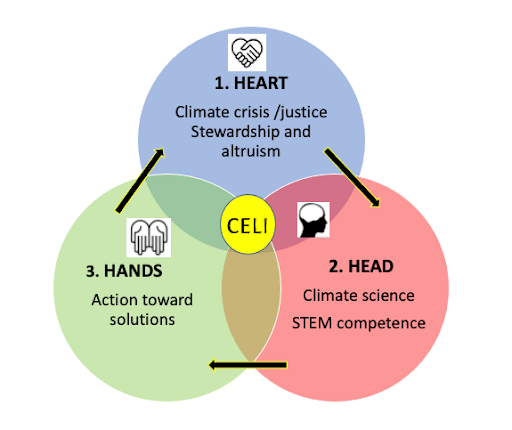
The Heart-Head-Hands approach immediately resonated for our CELI teachers, a recognition that deep learning, that lastingly transforms thinking and behaviors, requires learning in all three realms. Our CELI approach is a modification on what the literature refers to as the Head-Heart-Hands approach (e.g., Sipos 2008). Islam et al. (2022) articulately summarized the benefits of the approach: “This all-encompassing learning strategy appears to offer better opportunities for learning for education for sustainability because it engages and develops the full person, including their affective, cognitive, and practical dimensions and talents, in relation to real-world issues and concerns.” But in CELI, we begin with the heart because that is where our children suffer and that is where the commitment to act lives. The heart is the emotional hook that drives deep engagement in learning. It motivates head learning (analytical understanding of the causes, consequences and solutions to climate change) and hands learning (solutionary action competence). We use the model to structure both the annual curriculum, and within individual units.
Because climate learning can involve devastating, as well as empowering, emotions, and because we do not want to leave students lingering in a state of despair, we like to begin each CELI year with heart-inspiring CELI lessons. We start by focusing on youth climate action, foregrounding the voices of super-inspiring BIPOC youth that ‘look like’ our kids (for example Nalleli Cobo and Xiuhtezcatl Martinez) and powerful multi-racial youth climate actions like Youth v Gov. Our two key student texts also use climate action as a starting phenomenon (see Kline (2022) and Martinez (2020). Heart-related lessons are also used to facilitate students' need to process the trauma that lived or learned experiences of the climate crisis may cause. For example, a story of climate refugees in our sea-level-rise unit is used as a starting phenomenon that is highly relatable, but also potentially triggering, for a community consisting of many recent immigrants, including climate refugees.
Although climate curriculum is typically focused in the sciences, multi-disciplinary education (across many subjects) is a particularly effective way to facilitate deep Heart-Head-Hands learning. Art, language arts in particular offer excellent opportunities for reflection and processing, as does hands-on work in science classes and clubs. They also provide excellent opportunities for engaging students in envisioning positive futures. Physical education and social studies, on the other hand, offer numerous opportunities for hands-on and community engaged learning.
References:
- Islam, Md. Aminul et al. (2022) Conceptualization of head-heart-hands model for developing an effective 21st century teacher, Frontiers in Psychology, October 14, Available online.
- Kline, Naomi (2022). How to Change Everything: The Young Human's Guide to Protecting the Planet and Each Other. Simon and Schuster. (Student oriented book, also available in Spanish)
- Martinez, Xiuhtezcatl (2020). Imaginary Borders, Pocket Change Collective. (Student-oriented book.)
- Sipos, Y., et al. (2008). Achieving transformative sustainability learning: engaging head, hands and heart". International Journal of Sustainability in Higher Education, 9(1), 68-86. Available online.